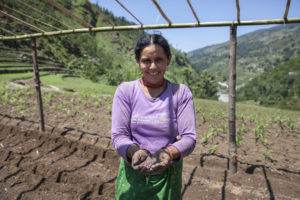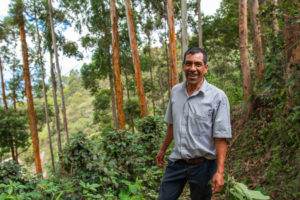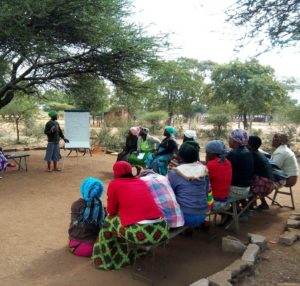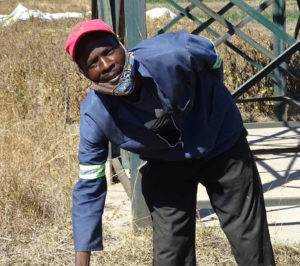What are Nationally Determined Contributions and what do they mean for people in Nepal, Peru and other countries on the front line of climate change?
Nationally Determined Contributions (NDCs) are non-binding plans by countries around the world, by which they communicate their work towards climate related targets for emission reductions and other measures that were set out in the Paris Agreement.
The Paris Agreement is an international treaty adopted by 196 countries at the 2015 United Nations Climate Change Conference, covering climate change mitigation, adaptation, and finance. Under the Agreement, countries must determine, plan, and regularly report on their contribution to adapt to climate change and the NDCs are an important part of this process.
The goals for each country laid out in their NDC include a commitment to working towards being climate neutral by 2050, limiting global warming to well below 2°C, and increasing efforts to limit warming to 1.5°C, as well as reductions in their emissions of greenhouse gasses. Although Article 3 of the Paris Agreement requires NDCs to be ambitious and present tangible progression, individual countries are free to determine their own contributions. Therefore, NDCs combine the top-down system of a traditional international agreement with bottom-up elements through which countries put forward their own goals and policies, in the context of their own national circumstances, capabilities, and priorities.
Joining Together to Tackle Climate Change
Every country needs to do its share for the goals laid out in the Paris Agreement to be achieved. However, every country is different, with varying circumstances, resources, and abilities. For this reason, each country chooses their own targets and contributions to the universal goal and outlines these in their NDC, describing their contributions and how they plan to achieve their mitigation and adaptation targets. For example, the UK has committed to reducing economy-wide greenhouse gas emissions by at least 68% by 2030, compared to 1990 levels. Many NDC documents also highlight how the changing climate will affect their country and how they plan to adapt to these changes. Taken as a whole, the NDCs add up to a global commitment towards meeting the aims of the Paris Agreement.
Nepal: On the Frontline of Climate Change
Nepal is one of the most climate-vulnerable countries in the world. This is because of the country’s extreme terrain and the fact that many of its people rely on farming to make a living.

Laxmi is using sustainable solar power to irrigate the crops on her Nepal farm and grow nutritious vegetables for her family
Nepal is committed to tackling climate change with the Paris Agreement, despite the fact that the country has done little to contribute to it in the first place. Still, they agree to do their part as limiting global average temperature rise to 1.5°C would significantly lower risks for all countries globally.
In its NDC, the government of Nepal has laid out its plan for socio-economic prosperity by building a climate-resilient society. It aims to achieve net-zero greenhouse gas emission by 2050. Sunil Acharya, a climate and resilience expert in our Nepal team, explains more:
“Nepal’s second NDC, submitted in December 2020, commits to strengthen climate action. It plans to reduce the fossil fuel dependency and increase the share of clean energy to the energy mix, with a focus on expanding access to energy and clean cooking solutions. The NDC also aims to prepare and implement climate resilient and gender-responsive adaptation plans in all the local governments level. Furthermore, the NDC pledges to establish multi-hazard monitoring and early warning system covering all the provinces.”
Our work in Nepal supports many of the government’s aims. For example, we are working with farmers in remote, mountainous regions to harness solar energy to irrigate their crops. This means people are able to grow enough food to feed their families, with extra cash crops to sell.
Peru: Protecting the Cloud Forests and Flood Early Warning
In Peru, deforestation is both a threat to the environment and to the smallholder farmers who rely on natural resources for their food and livelihoods.

Melanio is replanting trees on his Peru farm, protecting his family and land from flooding and conserving natural resources
Peru was hit particularly hard by Covid-19, with one of the highest per capita fatality rates in the world and highest infection rates in South America. With this in mind, the goal of Peru’s NDC is to implement mitigation and adaptation measures in line with national goals for economic development and poverty reduction.
Peru is currently revising its NDC target but has already announced it will move from a 30% to a 35% reduction of total emissions in its next NDC, while also aiming for carbon neutrality by 2050.
Working together with farmers in Peru, Practical Action is replanting trees in the country’s cloud forests. More trees don’t just mean lower carbon emissions – they also mean better protection from floods and landslides and improved soil fertility. All of which means that farmers can grow more crops more sustainably, while protecting themselves from extreme weather events like floods.
Our work in Peru has had national impact, as Practical Action’s head of climate and resilience, Colin McQuistan, explains:
“We’ve been working on flood early warning systems in Peru, Bangladesh and Nepal for many years and after seeing our success and recognising the need to meet the Paris Agreement targets, the national government of Peru have committed $13m to establish and expand early warning systems across the country. This is exactly the sort of ambitious action we want to see.”
The NDCs Have Never Been More Relevant
A 2020 report produced by the United Nations Environment Programme (UNEP) suggests that if all countries met their current NDC targets, we would still only be one third of the way towards achieving the Paris Agreement. In addition, many countries aren’t currently close to reaching their NDC targets.
However, public awareness around the importance of tackling climate change has skyrocketed over the last few years. Governments are starting to take notice, with the governments of 77 countries now pledging to go carbon neutral by 2050.
COP26 and Beyond
When the Paris Agreement was adopted in 2015, countries agreed to return in five years to make a new round of NDCs. This was delayed by a year due to the Covid-19 pandemic and new discussions were convened at COP26 in Glasgow in late 2021.
Countries whose initial commitments extended through 2025 were tasked to make new commitments, while countries whose commitments extended through 2030 would need to communicate or update them.
At the time of writing, 152 countries, amounting to 81.3% of global emissions, have either updated their existing NDC or submitted a new one, and 91 of those 152 have committed to further targets to reduce their total emissions, in comparison to their initial NDC. The Climate Watch website includes a tracker showing the current picture on an individual country basis as well as allowing country by country comparisons.
COP28
2023 has been confirmed as the hottest year on record, and human induced climate change is as least partly to blame. The climate crisis is no longer a niche idea, it’s now firmly in the public’s consciousness, and rightly so. Every year, leaders, politicians activists and NGOs like ours, come together to discuss the major issues and decide on a way forward at the UN Climate Change Conference of the Parties, otherwise known as COP (where ‘Parties’ is a descriptor for countries). 2023 was the 28th time that countries came together to discuss every aspect of climate change, hence COP28.
Click here to read more about Practical Action at COP28.
Author
Demet Intepe
Researcher and policy expert in climate justice, climate change adaptation, and sustainability. Currently leading on the mainstreaming of climate change adaptation and mitigation across Practical Action’s programmatic and policy work, as well as Practical Action’s organisational commitment to sustainability.


